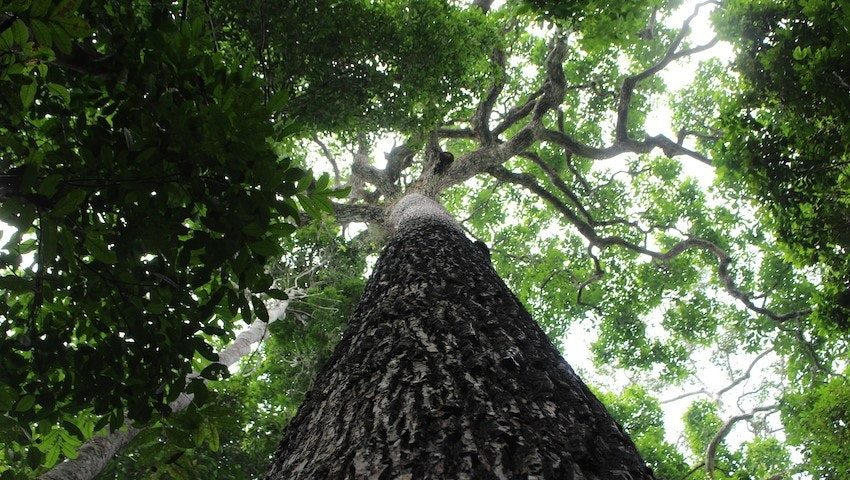
© VICTOR CAETANO-ANDRADEA towering Brazil nut tree in Jaú National Park in Brazil’s Amazonas state.
Evolving technologies hold the key to unlocking information
stored by ancient tropical trees, which have borne witness to human activities and environmental forces from pre-historic to industrial epochs.
"As trees grow, they absorb details about their surroundings into their wood, creating snapshots of the environment through time," says Victor Caetano-Andrade, from the Max Planck Institute in Germany.
The insights that can be gleaned from these "time capsules of cultural heritage" could help inform conservation efforts, according to a
review published by Caetano-Andrade and colleagues in the journal
Trends in Plant Science.
This is a mounting imperative, they write, as tropical forests are refuges for half of the Earth's biodiversity and
major mitigators of greenhouse gases.
However, the trees face numerous threats from
climate change and logging; an area equivalent to 40 football fields is being
deforested every minute.
The review discusses bringing together dendrochronology (the study of tree rings), radiocarbon dating, stable isotope in the wood and tree DNA to shine more light on questions about past human societies.
"We emphasise the importance of using these methods in dialogue with history and archaeology to understand the dimensions of human influence in tropical forests," says Caetano-Andrade.
Rather than forests being "pristine" prior to industrialisation,
evidence from trees, archaeological and historical records suggest prehistoric humans had far greater impacts on their ecology than previously thought.
And therein lies the learning for modern societies - understanding, for instance, how native communities managed their environment and interacted with the rainforests compared to invading colonies.
"When ancient humans constructed dwellings within the forest, they selectively created gaps in the canopy, allowing for additional light to cultivate preferred species," says Caetano-Andrade; "this is one way native societies influenced the establishment of trees within their territories."
Another example is the proliferation of brazil nuts (
Bertholletia excelsa) during precolonial times in the central Amazon tropics; after European invasion the native people were displaced, and those trees stopped propagating for nearly 70 years.
"This demonstrates how the forest actively responds to human occupation over time," he says.
Dozens of species were selectively cultivated and domesticated by ancient farmers, including the açaí (
Euterpe precatoria), cocoa (
Theobroma cacao), peach palm (
Bactris gasipaes) rubber tree (
Hevea brasiliensis) and papaya (
Carica papaya).
Caetano-Andrade hopes that adding the value of rainforests as repositories of cultural history to their other manifold benefits will boost efforts to preserve them and show how agriculture can thrive without depleting them.
"It's possible to think of economic models that can keep the forest standing. The proof is that it's been happening for thousands of years before colonial expansions, as native people developed economic systems that maintained and even enriched the forest," he says.
"This is becoming more and more urgent, since in the near future more than half of the people on the planet will be living in tropical environments and it is necessary to learn which are the most viable ways to live sustainably and preserve the forest so that future generations can also live in it."
Reader Comments
if you have not been there... Los Angeles is semi arid. much of the plant life there are succulents.
the place is literal proof of 'climate change' long before mankind ever arrived.
HOWEVER, I lived in SoCal for about 3 years between 78 and 84. I ALWAYS MEANT to visit the La Brea Tar Pits. (Hell, I worked at the LA Fed Building for 1.5 years during that time! NEVER MADE IT!
(We lived in the Mojave while my dad worked at Edwards in 62/63-65. Roadrunners, horned lizards (horny toads) et al. I know them well!
RC
We were taking a test on the 20th floor, and... a f*cking earthquake hit! (The only one I've been in.) It was based in Santa Monica bay, shallow, but as we were WAAAYY UP in a building, it was slinging and slap-catching on the North Wall/ then back to the S. wall. (You could HEAR the windows! Cool.)
*Something that YOU, HVAC Tech will appreciate: one day, I could tell that the starter on my 71 Plymouth Valiant was going. Before I left Florida, I'd gotten a trunkload full of spare parts from a friend who was going to be paid $30 for his 72 Dart, whether stripped or not. SO, during lunch, I skated back to the car, changed out the starter, and was back early.
RC